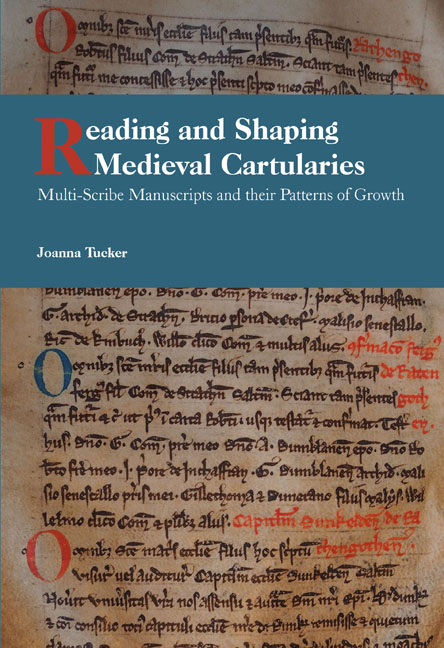Book contents
- Frontmatter
- Contents
- List of Plates
- List of Figures
- List of Tables
- Acknowledgements
- List of Abbreviations
- Conventions
- Introduction
- 1 Cartulary Studies
- 2 Analysing a Multi-Scribe Cartulary
- 3 The Creation and Growth of the Glasgow RV
- 4 The Creation and Growth of Lindores Caprington
- 5 Understanding the Patterns of Growth in Multi-Scribe Cartularies
- 6 Conclusion
- Appendix: Contents of the two Cartularies by ‘Series’
- Bibliography
- Index
- Studies in Celtic History
4 - The Creation and Growth of Lindores Caprington
Published online by Cambridge University Press: 13 April 2021
- Frontmatter
- Contents
- List of Plates
- List of Figures
- List of Tables
- Acknowledgements
- List of Abbreviations
- Conventions
- Introduction
- 1 Cartulary Studies
- 2 Analysing a Multi-Scribe Cartulary
- 3 The Creation and Growth of the Glasgow RV
- 4 The Creation and Growth of Lindores Caprington
- 5 Understanding the Patterns of Growth in Multi-Scribe Cartularies
- 6 Conclusion
- Appendix: Contents of the two Cartularies by ‘Series’
- Bibliography
- Index
- Studies in Celtic History
Summary
The second manuscript in this study is the oldest cartulary of Lindores Abbey. It is now housed in Caprington Castle in Ayrshire. The manuscript will therefore be referred to here as ‘Lindores Caprington’. Like the Glasgow RV, Lindores Caprington also experienced a significant phase of growth by piecemeal additions of text and folios. The methodology can therefore be readily applied to this manuscript.
This chapter will combine the approaches of Chapters 2 and 3. It will begin with the abbey's archival history and continue with an analysis of the cartulary manuscript according to the steps established in Chapter 2: examining the binding, establishing the collation and the series, investigating the scribal activity, identifying the contents, and applying relative dating (by series). The main body of the chapter will be an analysis of the scribal activity within each series, ending with a consideration of the institutional setting and cartulary's function. The manuscript's contents are presented in the Appendix, which is also technically the first time they have been published in their actual order, since the printed edition placed the earliest portion of the manuscript first. By the end of this chapter we will have two rich case studies of multi-scribe cartularies through which we can begin to explore wider questions about the patterns of growth and the nature of the medieval cartulary.
Lindores Abbey and its archive
The abbey of Lindores was founded by David, earl of Huntingdon, younger brother of two kings of Scots, Malcolm IV (1153–1165) and William the Lion (1165–1214). Today, its ruins sit on the eastern side of the town of Newburgh in Fife. The actual foundation of Earl David's monastery has a complex documentary history, some of which will be discussed below, but its original foundation must have been in the early 1190s. The abbey was dedicated to the Blessed Virgin Mary and St Andrew. It was set up with Tironensian monks from Kelso Abbey in the Scottish borders, whose abbot quitclaimed Lindores from all ‘subjection and obedience’ (subiectione et obedientia) in the 1190s. Lindores was the fifth Tironensian house in Scotland. The abbey was secularised in 1600, when Sir Patrick Leslie of Pitcairlie became the first Lord Lindores.
- Type
- Chapter
- Information
- Reading and Shaping Medieval CartulariesMultiple Scribes and Patterns of Growth, pp. 134 - 186Publisher: Boydell & BrewerPrint publication year: 2021

